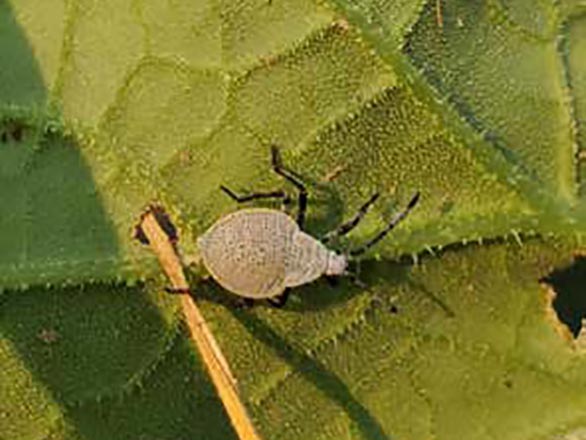 Scientific name: Anasa tristis
Scientific name: Anasa tristis
Order: Hemiptera
Description: Adult squash bugs are gray with brown wings, and oval-shaped with flattened abdomens. They often have alternating light- and dark-brown spots along the edges of the abdomen and are about a half inch long. Immature individuals are mostly gray, pear-shaped and wingless. Eggs are oval and red-to-bronze in color. They are laid in clusters on the stems and undersides of leaves.
Behavior: Squash bugs use their piercing-sucking mouthparts to extract plant sap. They often feed in large groups. Adults fly to find new host plants.
Life cycle: Squash bugs overwinter as unmated adults in protected areas around infested plants. Copper-colored egg masses are laid on the undersides of leaves and stems. Immature squash bugs (nymphs) go through several stages before becoming adults about six weeks later. At least two generations occur per year.
Diet and damage: Squash bugs are specialists on plants in the Curcubitaceae family, which includes cucumbers, melons, squash and pumpkins. Individuals feed on the undersides of leaves or on stems. Damage can include wilted leaves, reduced fruit production, damaged fruit and plant death.
Monitoring: Regular monitoring of plants is key to protecting plants from young squash bug damage. Once population numbers increase, they can be impossible to control without removing infested plants. Routinely check leaves and stems for egg masses or nymphs.
Control methods:
Cultural control: Remove winter refuge sites, such as dead plants or large woody debris, from near vegetable gardens. Trellising some crop varieties can limit the hiding places for individuals. A three-year crop rotation is effective at reducing the number of individuals nearby, though individuals will fly in from other locations. Squash bug-resistant varieties are available, but damage can still occur.
Mechanical control: Physical barriers, such as thin row covers, can prevent squash bugs from finding new seedlings. Barriers should be pulled back gradually over several days to allow pollinators to access the flowering plants. Hand- and tape-removal of eggs and vacuuming of nymphs and adults are effective ways to control small infestations in the garden. Nymphs and adults must be destroyed before disposal, or they will crawl out of vacuums and trash cans. Place pieces of wood or cardboard throughout the garden for monitoring, and check each morning to remove hidden squash bugs.
Biological control: Some beneficial invertebrates, such as spiders and wasps, will feed on squash bugs. Some native parasitoid wasps may also provide control.
Chemical control: Squash bugs are difficult to control chemically as adults. Several organic and synthetic contact sprays can be effective if timed appropriately to target younger nymphs and if coverage on the undersides of leaves is achieved. Sprays and dusts should be applied at the base of plants, where squash bugs congregate during the day. Diatomaceous earth can also be applied. Follow label instructions carefully. Repeated applications might be necessary.
K. Burls, W. Hanson Mazet, H.i Kratsch
2021,
A Northern Nevada Homeowner's Guide to Identifying and Managing Squash Bugs,
Extension, University of Nevada, Reno, FS-21-111


